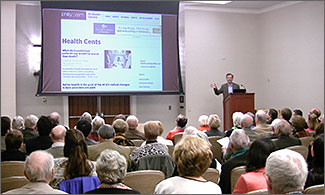News
ACA is Here to Stay Regardless of Election Outcome Say Penn Policy Experts
Annual Seminar Focuses on How Health Law May Evolve

Taking part in the University of Pennsylvania panel are (l to r) Daniel Polsky, PhD, Executive Director of the University of Pennsylvania Leonard Davis Institute of Health Economics (LDI); Robert Field, PhD, JD, Drexel University Law Professor and Penn Lecturer; Julie Sochalski, PhD, RN, Associate Dean, Penn Nursing School; Tom Baker, JD, Penn Law Professor; and David Grande, MD, MPA, Assistant Professor of Medicine at Penn’s Perelman School of Medicine.
No matter who wins the U.S. Presidential election, the Affordable Care Act is unlikely to go away — but is likely to undergo substantial changes, according to a panel of top health policy experts at the University of Pennsylvania.
Convened for the the annual Charles C. Leighton Memorial Lecture at Penn’s Leonard Davis Institute of Health Economics (LDI), the panel, moderated by LDI Executive Director Daniel Polsky, focused on the question of how health reform policy might be altered by an incoming President of either party.
The Democratic candidate calls for expansion of the ACA provisions; the Republican standard-bearer wants the health care law repealed.
“At this point it would be very difficult — I say impossible — to eliminate the ACA,” said panelist Robert Field, a Professor of Health Management and Policy at Drexel and lecturer in Health Care Management at Penn. “There are powerful corporate interests that now rely on the ACA,” he said. “Drug companies and insurance companies have huge new markets through it. Hospitals have less indigent care because of it. Whole new industries have popped up related to its requirements and needs. Large numbers of consumers have a strong stake in it. Overall, the ACA is now interwoven into other public programs in ways that would make it very hard to extract.”
“The bottom line is that the ACA is here to stay no matter who takes the White House,” said Field, who is also an LDI Adjunct Senior Fellow.

At the annual LDI Leighton Lecture in the ballroom at the Inn at Penn, is attorney and health care management professor Robert Field.
Insurance exchange pricing
Penn Law School Professor and insurance law scholar Tom Baker pointed to insurance exchange pricing as one of the ACA elements that needs to be changed by the next administration.
“The exchanges are working in the technical sense,” he said, “but the thing that is not working well is risk pool management. The companies that have recently exited the exchanges cite the same issue: the difficulty of setting prices because they don’t know who is going to be buying their policies. One achievable, technical — and maybe expensive — fix would be to have the government guarantee who is in the risk pool so that insurers could price appropriately.”
The cause of this pricing problem is that fewer than expected young healthy people signed up in the ACA exchanges, leaving insurers with risk pools dominated by much sicker — and more costly — clients.
Complicated Medicaid issues
Panelist David Grande pointed out that much of the debate about whether or not the ACA is fulfilling its goal overlooks complicated Medicaid issues.
“When the law was designed, half its coverage was anticipated to come through the new health insurance exchanges and the other half was to come from the expansion of Medicaid programs in all states,” said Grande who is an Assistant Professor of Medicine at Penn’s Perelman School of Medicine and LDI’s Director of Policy.
But that nationwide expansion of Medicaid programs was thwarted by the Supreme Court decision that upheld the ACA but overturned the provision empowering the federal government to force states to expand their Medicaid programs. Currently, 38 percent of the states decline to broaden their Medicaid programs.
“As a new administration takes office,” Grande continued, “my biggest hope is that the ACA-related politics at the state level will evolve. People protested when the original Medicaid program was created in 1965 and it took 17 years for all states to get onboard. Hopefully as we get further removed from the politics of the initial creation of the ACA and recognize that the program is here to stay and makes financial sense, more states will opt into Medicaid expansion.”
ACA vs. Republican alternative
Panelist Julie Sochalski noted that despite the seemingly bitter political divide over the health care law, the proposed Republican alternative plan is “very similar” to the ACA and a realpolitik approach for a new President might be to “give the ACA a new name.”
“There are many things that are deeply rooted in the way we access care if you believe both sides of the aisle,” she said. “What Republicans have put forward as their own health care plan has many features comparable to the ACA. The items that differ include whether people will be required to have health insurance; that would go away. The coverage for people with pre-existing conditions would stay but would be limited.”
Sochalski, an Associate Dean in Penn’s Nursing School and the former Director of the Division of Nursing at the U.S. Department of Health and Human Services, also addressed audience queries about a potential change to a single-payer or “Medicare for all” health care system. She warned that such a move had significant workforce implications.
As a researcher and a former Director of the Division of Nursing at the U.S. Department of Health and Human Services, Sochalski is concerned about health care workforce trends that appear to be at odds with changing patient demographics and needs. The Baby Boomer generation is aging into a record-sized population of chronic diseases sufferers requiring more nursing services than ever before. Yet, nursing is facing a potentially record number of retiring nurses as too few new ones are available.
$1 trillion in waste
During the Q&A session, one audience member asked the panel how the ACA could be changed to better address the oft-cited estimate that as much as $1 trillion of the country’s $3 trillion health care spending is waste that does not benefit patients.
“That’s an incredibly difficult problem,” responded David Grande. “We’ve had the government try to set artificial ceilings on how fast costs can grow with no mechanism that could do anything about it. We’ve been through an era of asking insurers to do it (control costs) and there was a huge amount of public backlash. The current policies ask doctors to do it by paying them differently and making the hospitals they’re affiliated with accountable for total spending. And patients are being asked to do it by bearing a lot more out-of-pocket costs but that’s created a lot of access problems.”
“The big question facing the next administration,” said Grande, “is this: Are these new ways of paying doctors and hospitals going to make a difference or are we just creating a whole lot of health care industry consolidation that’s going to drive prices up even further in the future?”
THE LEIGHTON LECTURE An annual event of Penn’s Leonard Davis Institute of Health Economics, the Leighton Memorial Lecture series honors the memory of the late Charles C. Leighton, MD, who was senior Vice President of Administration, Planning and Science Policy at Merck & Co.
An annual event of Penn’s Leonard Davis Institute of Health Economics, the Leighton Memorial Lecture series honors the memory of the late Charles C. Leighton, MD, who was senior Vice President of Administration, Planning and Science Policy at Merck & Co.